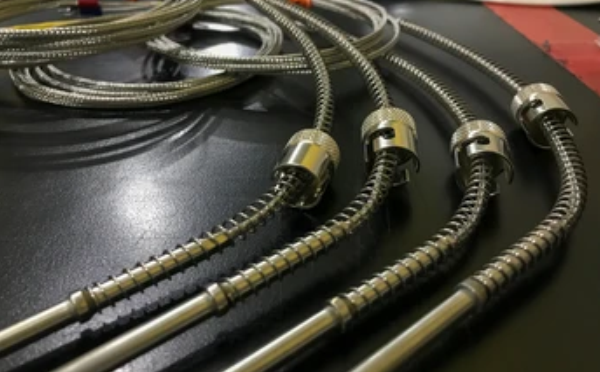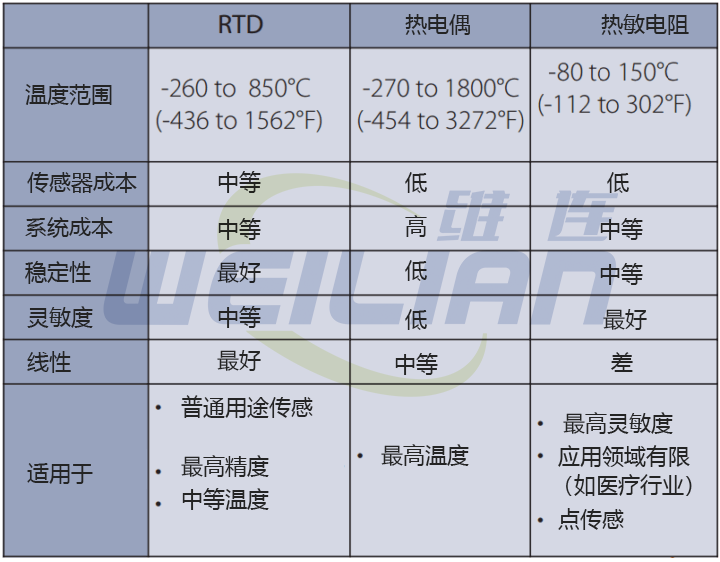
 Differences among RTDs, thermocouples and thermistors
Differences among RTDs, thermocouples and thermistors
Resistance temperature sensor (RTD)
RTD sensing element is composed of coil or pure metal deposition film. The resistance of the element increases with temperature in a known and repeatable manner. RTD shows excellent accuracy in a wide temperature range, and is the fastest growing part of industrial temperature sensors. Their advantages include:
●Temperature range: RTD temperature sensor models cover a temperature range of - 260 to 650 ° C (- 436 to 1202 ° F).
●Repeatability and stability:Platinum resistance thermometer is the main interpolation instrument used by National Institute of Standards and Technology in the range of - 260 to 962 ° C. Ordinary industrial RTDs usually drift less than 0.1 ° C/year.
●Sensitivity: The voltage drop across the RTD provides a much larger output than the thermocouple.
●Linear:Platinum and copper RTD sensor types produce a more linear response than thermocouples or thermistors. The linearity of RTD non metric sensor can be corrected by the correct design of resistance bridge network.
●Low system cost: The RTD sensor type uses ordinary copper extension wire, which does not require cold junction compensation.
●Standardization:The manufacturer provides RTDs that conform to the industry standard curve. The most common is 100 Ω platinum that conforms to EN60751
Thermocouple
The thermocouple consists of two wires of different metals welded together. At the other end of the signal line, usually as part of the input instrument, is another junction called the reference junction, which electronically compensates its ambient temperature. Heating the sensing junction produces a thermoelectric force (emf) that is proportional to the temperature difference between the two junctions. This millivolt electromotive force indicates the temperature of the sensing tip when compensating for the known temperature of the reference junction.
Thermocouples are simple and familiar. However, due to the need for special extenders and reference junction compensation, it is very complex to design them into the system. The advantages of thermocouples include:
●Extremely high temperature capacity:Thermocouples with precious metal junctions may be rated up to 1800 ° C (3272 ° F).
●Robustness:The inherent simplicity of thermocouples makes them resistant to shock and vibration.
●Small size/fast response:Thin wire thermocouple junction takes up less space and is light in weight, which is suitable for point sensing and rapid response. Note, however, that many RTDs have faster time constants than equivalent thermocouples.
Thermistor
Thermistor is a kind of resistance device, which is composed of metal oxides formed into beads and encapsulated in epoxy resin or glass.
A typical thermistor shows a large negative temperature coefficient. The resistance decreases sharply and nonlinearly with temperature. The sensitivity is many times that of RTD, but the available temperature range is limited. Some manufacturers offer thermistors with positive coefficients. You can also use linear models.
The performance and price of thermistors from different sources vary greatly. Typical benefits are:
●Low sensor cost:Basic thermistors are very cheap. However, models with tighter interchangeability or extended temperature ranges are generally more expensive than RTDs.
●High sensitivity:Each temperature change of the thermistor may change the resistance of dozens of ohms, while the resistance change of RTD is only a fraction of an ohm.
●Point sensing:Thermistor beads can be made into needles for small area sensing.
Differences among RTD temperature sensors, thermocouples and thermistors

